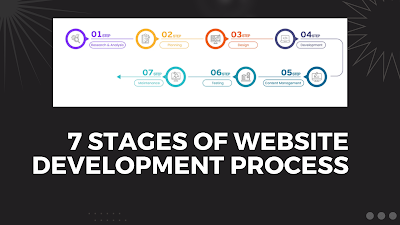7 Stages of Website Development Process: A Step-by-Step Guide for 2023
Website development is a multifaceted process that requires careful planning, design, and execution to create a successful online presence. In 2023, as the digital landscape continues to evolve, it's crucial to stay up-to-date with the latest trends and technologies to ensure your website not only looks great but also functions seamlessly. In this comprehensive guide, we'll take you through the seven essential stages of website development, providing you with a step-by-step roadmap to create a website that stands out and delivers results.
1. Research and Analysis:
To initiate any process, it is imperative to conduct thorough research and analysis pertaining to the website. The crucial components of this research involve establishing a clear objective and accumulating a comprehensive pool of available information.
Key inquiries that must be addressed when formulating an objective include identifying the target audience, understanding the website's offerings, and determining its primary purpose, be it informational, navigational, or transactional. In the case of a service-based company, it is essential to outline the diverse array of services accessible to all user types. Lastly, an exploration of the website's competitors is highly advisable, as it provides valuable insights and serves as a source of inspiration to deliver optimal outcomes.
The first stage of website development is research and analysis. This phase involves understanding your target audience, competitors, and industry trends. Key tasks include:
Identifying your website's purpose and goals.
Conducting market research to identify your target audience's needs and preferences.
Analyzing competitor websites to gather insights and identify gaps.
Creating user personas to guide design and content decisions.
2. Planning:
Once all the requisite information has been collected, the next step involves the planning of sitemaps and wireframes. During this phase of development, the developer enables users or customers to experience the flow of information acquired in the previous stage.
A sitemap serves as a means to interconnect all the primary facets of your website, offering a comprehensive view of the internal structure of your business. Furthermore, it facilitates an understanding of the connections between different pages and, most importantly, provides effortless navigation through the site.
On the other hand, a wireframe provides a visual representation of the website's features and services in a more easily comprehensible manner. This representation encompasses elements such as login interfaces, subscription options, live chat functionality, and more.
The estimated timeframe for completing this process typically falls within the range of 3 to 6 weeks, depending on the clarity and effectiveness of the interface design.
Once you've gathered valuable insights, it's time to create a solid plan for your website. During this stage, you'll:
Develop a clear sitemap and site structure.
Outline the website's functionality and features.
Create a detailed project timeline and budget.
Choose the right technology stack and content management system (CMS).
3. Design:
The website design phase stands as a pivotal step in the website construction process, significantly contributing to your business's ultimate success. Effective design serves as a magnet for users, and as such, it must be tailored to cater to the specific audience your business targets.
Nonetheless, when thorough research is conducted during the initial stage, executing this phase becomes a more straightforward task. For instance, designing a website for an e-commerce venture vastly differs from crafting one for a medical facility. Every element, including website themes, layouts, color schemes, imagery, videos, and more, carries equal weight in creating an engaging website and elevating it to new heights, devoid of design flaws.
This stage encompasses three critical components: establishing the page layout, conducting design reviews, and securing approval from management. Consequently, the estimated duration for completing this web development phase typically ranges from 5 to 12 weeks, contingent upon the complexity of graphical representation and user interface requirements.
Design is a critical stage in website development, as it determines the overall look and feel of your site. Key tasks include:
Creating wireframes and prototypes to visualize the site's layout and user interface.
Choosing a color scheme and typography that aligns with your brand identity.
Designing graphics, logos, and other visual elements.
Ensuring the website is responsive and mobile-friendly.
4. Development:
Up to this point, the focus has been on crafting the visual and graphic elements of the website. As we transition into the development phase, the majority of the work shifts toward the creation of the programmable code that ensures the website's seamless functionality.
During the initial stages, the primary focus was on constructing the home page and landing pages, with the subsequent addition of remaining pages in accordance with the sitemap's structure. Consequently, the estimated timeline for completing this process may fluctuate, typically falling within the range of 15 to 20 weeks.
With the design in place, the development phase begins. Skilled developers bring your design and functionality to life. Key tasks include:
Writing clean, efficient code using web development languages like HTML, CSS, and JavaScript.
Integrating the chosen CMS and developing custom features.
Implementing SEO best practices for on-page optimization.
Testing and optimizing website performance.
5. Content Management:
Following the design and development of your website, the next crucial phase is content management. Content management plays a pivotal role in your business's success as it dictates what is communicated to your customers. The effectiveness of content management hinges on your ability to organize information and convey your message to customers seamlessly, without compromising quality or introducing unnecessary complexity.
Creating compelling content encompasses various aspects, from crafting engaging headlines to meticulous proofreading, structuring paragraphs, and incorporating visual elements, among others. In today's competitive landscape, integrating effective SEO practices is essential to maintain a prominent online presence. Staying well-informed about search engine result pages (SERPs) and staying updated on industry-specific changes is imperative.
Achieving a comprehensive understanding and producing high-quality content for the initial phase may typically require 5 to 10 weeks. However, it's crucial to emphasize that content updates should be conducted regularly to prevent any adverse impact on the website's metrics. Neglecting routine updates can directly affect the site's performance.
Content is king on the web, and effective content management is crucial for a successful website. In this stage, you'll:
Create high-quality, SEO-optimized content, including text, images, and videos.
Organize and categorize content for easy navigation.
Implement a content publishing schedule and workflow.
Train staff or clients on how to update and manage the website's content.
6. Testing:
Testing stands as a pivotal phase in the website development process, where all the preparations made thus far are geared towards ensuring a seamless website launch. During the testing phase, every aspect of the website, including each page and line of code, undergoes rigorous examination before the website is made live. This comprehensive testing process extends to forms, scripts, and all programmed code, subjecting them to various scenarios and devices to guarantee flawless website performance.
Before launching your website to the public, it's essential to thoroughly test it for functionality, compatibility, and security. Key testing tasks include:
Conducting usability testing to ensure a smooth user experience.
Checking cross-browser and cross-device compatibility.
Testing website security to protect against potential threats.
Conducting performance testing to optimize load times.
7. Maintenance:
What is the foremost role of a website? Is it merely a one-time service delivery to its users? No, it must undergo continuous updates and maintenance to fulfill its objectives. Ensuring the website operates smoothly and keeps pace with market changes on your platform is imperative.
A reliable method to maintain the website is by implementing a feedback system, allowing prompt resolution of user issues. Establishing a support team to address inquiries related to the website's services fosters strong customer and brand relationships.
Failure to adequately maintain the website can result in the loss of potential customers. Hence, beyond development and design, maintenance plays a pivotal role in bringing the website to life.
Once you grasp the entirety of the website creation process, your focus shifts to operationalizing the website. Web developers are tasked with crafting a user-friendly, functional website with an innovative user interface. In the subsequent section, you'll delve into the three types of development necessary to make your website fully functional.
Website development is an ongoing process, and regular maintenance is essential to keep your site running smoothly. In this final stage, you'll:
Monitor website performance and user feedback.
Apply updates and security patches to keep the site secure.
Add new content, features, or improvements based on user needs.
Continuously analyze website analytics to make data-driven decisions.
Conclusion:
In Bangalore, SEO Digitz is a leading Web Design Company Bangalore. Providing the best web design services worldwide, we are Bangalore leading web design company in Bangalore. Our goal is to help your business succeed online by creating engaging and affordable websites. User-centered design and branding engage clients and increase brand value.
For More View:
Best Android Apps Development Company Bangalore | Android Apps Development Company Bangalore | Android Apps Development Companies Bangalore
Best iPhone Apps Development Company Bangalore | iPhone Apps Development Company Bangalore | iPhone Apps Development Companies Bangalore | Website Design companies Bangalore



Comments
Post a Comment